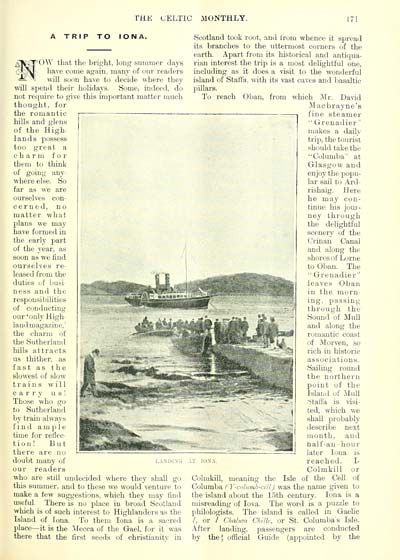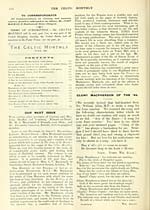Blair Collection > Celtic monthly > Volume 4, 1896
(245)
Download files
Complete book:
Individual page:
Thumbnail gallery: Grid view | List view

THE CELTIC MONTHLY.
A TRIP TO
A^t;7^0^^' that the brifrht, long summer clays
^b!\j| have come again, many of our readers
^ '^' will soon have to decide where they
will spend their holidays Some, indeed, do
not require to give this important matter mucli
thought, for
the romantic
hills and glens
of the High-
lands possess
too great a
c h a r m f o r
them to think
of going any-
where else. So
far as we are
ourselves con-
cerned, no
matter what
plans we may
have formed in
the earlj' part
of the year, as
soon as we find
ourselves re-
leased from the
duties of busi-
ness and the
responsibilities
of con due tin).'
our 'only High-
laudmagazine,'
the charm of
the Sutherland
bills attracts
us thitbei', as
fast as the
slowest of slow
trains will
c a r r J' us!
Those who gu
to Sutherlan< 1
by train always
find ample
time for retlec-
tiou! But
there are no
doubt many of
our readers
who are still undecided where they shall go
this summer, and to these we would venture to
make a few suggestions, which they may find
useful. There is no place in broad Scotland
which is of such interest to Highlanders as the
Island of lona. To them lona is a sacred
place— it is the ATecca of the Gael, for it was
there that the first seeds of christianitv in
Scotland took root, and from whence it spread
its branches to the uttermost corners of the
earth. Apart from its historical and antiqua-
rian interest the trip is a most delightful one,
including as it does a visit to the wonderful
island of Staffa, with its vast caves and basaltic
pillars.
To reach Oban, from which Mr. David
Macbrayne'e
fine steamer
" Grenadier '
makes a daily
trip, the tourist
should take the
"Columba" at
Glasgow and
enjoy the popu-
lar sail to Ard-
rishaig. Here
he ma}' con-
tinue his jour-
ney through
the delightful
scenery of the
Crinan Canal
and along the
shores of Lome
to Oban. The
" Grenadier"
leaves Oban
in the morn-
ing, passing
through the
Sound of Mull
and along the
romantic coast
of Morven, so
rich in historic
associations.
SaiLLng round
the northern
point of the
Island of JIull
■Stafla is visi-
ted, which we
shall probably
tlescribe nest
month, and
half-an - hour
later lona is
'.T lo.NA. reached. I-
Colmkill or
Colmkill, meaning the Isle of the Cell of
Columba (V-cn/iimb-ci//) was the name given to
the island about the 15th century. lona is a
misreading of lova. The word is a puzzle to
philologists. The island is called in Gaelic
/, or / Chalum Chilh\ or St. Columba's Isle.
After landing, passengers are conducted
by the ^ official Guide (appointed by the
A TRIP TO
A^t;7^0^^' that the brifrht, long summer clays
^b!\j| have come again, many of our readers
^ '^' will soon have to decide where they
will spend their holidays Some, indeed, do
not require to give this important matter mucli
thought, for
the romantic
hills and glens
of the High-
lands possess
too great a
c h a r m f o r
them to think
of going any-
where else. So
far as we are
ourselves con-
cerned, no
matter what
plans we may
have formed in
the earlj' part
of the year, as
soon as we find
ourselves re-
leased from the
duties of busi-
ness and the
responsibilities
of con due tin).'
our 'only High-
laudmagazine,'
the charm of
the Sutherland
bills attracts
us thitbei', as
fast as the
slowest of slow
trains will
c a r r J' us!
Those who gu
to Sutherlan< 1
by train always
find ample
time for retlec-
tiou! But
there are no
doubt many of
our readers
who are still undecided where they shall go
this summer, and to these we would venture to
make a few suggestions, which they may find
useful. There is no place in broad Scotland
which is of such interest to Highlanders as the
Island of lona. To them lona is a sacred
place— it is the ATecca of the Gael, for it was
there that the first seeds of christianitv in
Scotland took root, and from whence it spread
its branches to the uttermost corners of the
earth. Apart from its historical and antiqua-
rian interest the trip is a most delightful one,
including as it does a visit to the wonderful
island of Staffa, with its vast caves and basaltic
pillars.
To reach Oban, from which Mr. David
Macbrayne'e
fine steamer
" Grenadier '
makes a daily
trip, the tourist
should take the
"Columba" at
Glasgow and
enjoy the popu-
lar sail to Ard-
rishaig. Here
he ma}' con-
tinue his jour-
ney through
the delightful
scenery of the
Crinan Canal
and along the
shores of Lome
to Oban. The
" Grenadier"
leaves Oban
in the morn-
ing, passing
through the
Sound of Mull
and along the
romantic coast
of Morven, so
rich in historic
associations.
SaiLLng round
the northern
point of the
Island of JIull
■Stafla is visi-
ted, which we
shall probably
tlescribe nest
month, and
half-an - hour
later lona is
'.T lo.NA. reached. I-
Colmkill or
Colmkill, meaning the Isle of the Cell of
Columba (V-cn/iimb-ci//) was the name given to
the island about the 15th century. lona is a
misreading of lova. The word is a puzzle to
philologists. The island is called in Gaelic
/, or / Chalum Chilh\ or St. Columba's Isle.
After landing, passengers are conducted
by the ^ official Guide (appointed by the
Set display mode to: Large image | Transcription
Images and transcriptions on this page, including medium image downloads, may be used under the Creative Commons Attribution 4.0 International Licence unless otherwise stated. ![]()
| Early Gaelic Book Collections > Blair Collection > Celtic monthly > Volume 4, 1896 > (245) |
|---|
| Permanent URL | https://digital.nls.uk/75849944 |
|---|
| Shelfmark | Blair.56 |
|---|---|
| Additional NLS resources: | |
| Attribution and copyright: |
|
| Description | A selection of books from a collection of more than 500 titles, mostly on religious and literary topics. Also includes some material dealing with other Celtic languages and societies. Collection created towards the end of the 19th century by Lady Evelyn Stewart Murray. |
|---|
| Description | Selected items from five 'Special and Named Printed Collections'. Includes books in Gaelic and other Celtic languages, works about the Gaels, their languages, literature, culture and history. |
|---|

